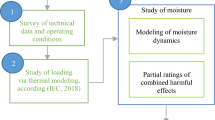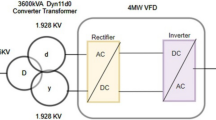Summary
A moisture model determines the moisture distribution in cellulose and oil. The model focuses on oil flow, moisture vapour pressure and the saturation properties of oil and cellulose. Measurements of material properties form the basis of each computation model. Direct measurements were performed. Samples of paper and pressboard were aged in oil. The measurements of moisture absorption were performed in air. For given moisture content the moisture vapour pressure reaches lower values than in previous results. Consequently, moisture values in oil reach lower values and the risk of bubbling at rising temperatures reduces. It has, for the first time, been established that bubbling requires a contribution of dissolved gas like air to reach critical vapour pressure levels to obtain bubbling at 150 °C hotspot and with 3% average moisture content and 1.2% in the hotspot respectively. Here oil must absorb on atmosphere air at 70 °C. Without dissolved gas an average moisture content of 4% and a hot spot temperature of about 165 °C would be necessary to come close to a risky condition. The low tendency to bubbling is also favoured by the reduced moisture content in the winding hotspot insulation which is caused by the temperature distribution due to axial oil gradient and winding gradient. The general calculation for individual spots in the transformer insulation like the hotspot is based on the moisture vapour pressure of cellulose and oil as the driving force of moisture migration. The axial temperature distribution, however, generates an axial gradient of moisture vapour pressures in oil. The cellulose insulation reaches the moisture pressure level of its neighbouring oil. The average cellulose moisture content provides basic information about the moisture condition. The calculation model is required to determine the moisture values in a transformer under operation conditions. Aging and bubbling considerations are based on the moisture content of the hotspot. Filling of a transformer with oil often happens at a moisture content of 5 ppm. At low temperatures and slow moisture diffusion into the bulk material the cellulose surface can develop extremely high moisture values. Therefore, a high temperature during filling is recommended. Furthermore, a transformer can, in principle, absorb moisture from the atmosphere or vice verse. The direction of migration is determined by the difference of local moisture vapour pressure between oil and atmosphere which depends on temperature and moisture. The slow migration velocity at low temperatures and tightness of the tank limits the value to below 7% moisture content in cellulose.
Similar content being viewed by others
References
Fessler, W. A., Rouse, T. O., McNutt, W. J., Compton, O. R. (1989): A Refined Mathematical Model for Prediction of Bubble Evolution in Transformers. IEEE Transactions on Power delivery, Vol. 4, No. 1, January, 1989
Koch, M., Tenbohlen, S. (2006): Der Bubble-Effekt und das Risiko eines dielektrischen Fehlers in Leistungstransformatoren. ETG: Diagnostik elektrotechnischer Betriebsmittel, 19. – 20. September, 2006, Kassel, Deutschland
Oommen, T. V. (2000): Bubble Evolution from Transformer Overload. IEEE Insulation Life Subcommittee, Niagara Falls, Canada, October 17, 2000
Scala, M., Buchgraber, G., Seitlinger, W. (2004): Transformer Overloading, utilizing an on-line thermo-hydraulic Transformer Model. Cigré Symp. Shanghai, 8–10 April, 2003, presented at Cigré Symp. Slovenia: Development and operation of interconnections in a restructuring context, Ljubljana, 4–6 April, 2004
Author information
Authors and Affiliations
Rights and permissions
About this article
Cite this article
Scala, M. Moisture assessment in transformers including overloading limits. Elektrotech. Inftech. 125, 439–443 (2008). https://doi.org/10.1007/s00502-008-0596-y
Issue Date:
DOI: https://doi.org/10.1007/s00502-008-0596-y




